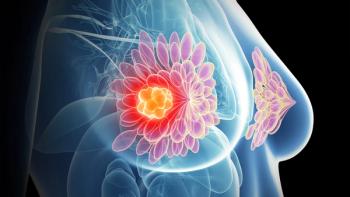
Anthony S. Fauci Talks COVID-19, Impact on Cancer, and More
The situation with the coronavirus-19 pandemic continues to rapidly evolve, but one thing is clear: this is much more than just the common cold.
The situation with the coronavirus-19 (COVID-19) pandemic continues to rapidly evolve, but one thing is clear: this is much more than just the common cold, Anthony S. Fauci, MD, director of the National Institute of Allergy and Infectious Diseases, said in the keynote presentation of the AACR Virtual Meeting on COVID-19 and Cancer.1
“Obviously, this is not just a human infection, since bats and other intermediate hosts are important reservoirs of this virus,” said Fauci. “Prior to severe acute respiratory syndrome (SARS) and Middle East respiratory syndrome (MERS), 4 coronaviruses were responsible for approximately 15% to 30% of the recurring common colds that we all get usually during the winter season. The issue of the possibility of a coronavirus being a pandemic came upon us in 2002 with SARS, and then again in 2012, with MERS.”
SARS, a viral respiratory disease caused by SARS-associated coronavirus, was first identified at the end of February 2003 during an outbreak that arose in China and then subsequently spread to 4 other countries.2 A total of 8098 individuals worldwide fell ill with the virus during the outbreak and 774 of them died.3 In the United States, only 8 individuals showed laboratory evidence of infection. All who had the virus had traveled to other parts of the globe where the virus had been spreading.
“There are some substantial differences between this SARS and what we'll refer to as [COVID-19]. The [2003] outbreak was contained by several strategies, such as isolation of cases, infection control measures, quarantine, travel advisories, and screening at airports,” said Fauci. “It was clear that although this was relatively easily transmitted from person to person, it did not have the absolute overwhelming efficiency and capability of spreading from human to human.”
Notably, public health measures such as physical separation and wearing a mask, were ultimately was led to the control of the outbreak—no drugs or vaccines, noted Fauci. “By the time we got to June or July of 2013, there were essentially no cases,” Fauci said.
A decade later, in 2012, another “pandemic-potential” coronavirus emerged, one that was first reported in Saudi Arabia.4 This coronavirus spread from a bat, to a camel, to a human, noted Fauci. From 2012 to 2020, the World Health Organization reported a total of 2519 cases and 866 deaths, with a case fatality rate of 34.4%; notably approximately 80% of these cases were reported in Saudi Arabia.5
“Notably, MERS is still smoldering up to this day. The outbreak is moderately well, if not well controlled, since the number of cases is relatively small, but we still have cases popping up, unlike SARS, which essentially disappeared,” said Fauci.
COVID-19 is a disease caused by the novel coronavirus SARS-CoV-2 because of its close phylogenetic proximity to the original SARS coronavirus. In mid-July 2020, approximately 14 million cases have been reported on a global scale, according to Fauci, with over 580,000 fatalities. “And essentially, there is no end in sight,” said Fauci. “The United States has been hit harder than any other country in the world, with the most cases, at 3.4 million, and the most deaths, at approximately 136,000.”
COVID-19 is a beta coronavirus in the same subgenus as the SARS virus and several bat-associated coronaviruses; it is an enveloped, positive-sense, single-stranded RNA virus and it has several structural proteins, including S, E, M, and N. The S protein, however, is the most important, as it allows for the virus to attach to, fuse with, and enter the host cell via the ACE2 cellular receptor, explained Fauci.
Regarding transmission, COVID-19 is known to be spread through the respiratory route, directly from person-to-person, usually in close contact. The virus can be transmitted via respiratory droplets that typically drop within 3 to 6 feet from the time they were expelled.
“However, now there is considerable interest in the relative role of aerosol transmission, namely with droplets that are less than 5 micrometers,” said Fauci. “The extent to which this is responsible for the spread is unclear, but most people feel that it has some impact.”
The virus has also been identified in non-respiratory specimens, such as stool, blood, ocular secretions, and semen; however, the role in their transmission remains unclear. Additionally, there is no evidence to suggest that animals, including domesticated animals, are a major source of infection in humans.
Importantly, it has been confirmed that anywhere from 20% to 45% of individuals who are infected with COVID-19 are asymptomatic.6 The clinical presentation of the virus typically manifests in a fever (83%-99%), cough (59%-82%), fatigue (44%-70%), anorexia (40%-84%), shortness of breath (31%-40%), and myalgias (11%-35%). Other nonspecific symptoms include sore throat, nasal congestion, headache, diarrhea, nausea, and vomiting. Notably, preceding the onset of respiratory symptoms, individuals might lose their sense of smell or taste.
“The thing that I’ve been most impressed with is, of all the viruses that I have been dealing with over the past several decades, we’re seeing an extraordinarily wide spectrum of disease where you get 20% to 45% of people who are completely asymptomatic and several others who could be pre-symptomatic in their spread,” said Fauci. “Then you have those with a range of mild illness, people who need to stay home for a few days; people who are in bed for weeks and have post-viral syndromes; people who require hospitalizations, and when in the hospital, require oxygen, intensive care, intubation, ventilation; and even death. It’s extraordinary that we have so many people who have no symptoms at all and then those whose outcomes are very [severe].”
Available evidence also suggests that individuals who are at increased risk of severe COVID-19 infection include older adults and those of any age with certain underlying medical conditions, such as asthma, cerebrovascular disease, hypertension, pregnancy, smoking, use of corticosteroids or other immunosuppressive treatments, bone marrow transplantation, HIV, immune deficiencies, inherited metabolic disorders, neurologic conditions, other chronic lung diseases, liver disease, and more.
Additionally, an analysis of data collected in the COVID-19 and Cancer Consortium registry and presented during the 2020 ASCO Virtual Scientific Program indicated that patients with progressive cancer were 5.2-times more likely to die within 30 days of being diagnosed with COVID-19 versus patients in remission or with no evidence of disease.7
When looking at age-associated COVID-19-associated hospitalization rates by race and ethnicity in the United States from March 1, 2020 to July 4, 2020, it is clear that there is a disproportionately higher rate of hospitalization among minority communities, such as those who are American Indian/Alaska Native, black, non-Hispanic, and Hispanic/Latino, noted Fauci.
With regard to cancer, it is estimated that COVID-19—related reductions in cancer screening and treatment over the next decade could potentially result in 10,000 excess deaths from breast and colorectal cancer, added Fauci.8 Beyond care, the pandemic has resulted in “an unprecedented disruption throughout the cancer research community, shuttering many labs and slowing down cancer clinical trial operations,” said Fauci.
With regard to testing, 3 tests are now available and being utilized during this time: molecular tests, which detect genetic material from the virus; antigen tests, which identify proteins from the virus; and antibody tests, which identify proteins in blood made in response to infection with the virus. “We’re trying to track that durability of that antibody response, but it’s really quite unclear how long these antibodies last,” said Fauci. “This is something we’re going to follow very closely.”
Several investigational therapeutics are under currently under investigation. The first randomized, placebo-controlled trial in this arena was one that was looking at remdesivir (Veklury). Results from a trial which enrolled 1063 participants in 10 countries over the course of 58 days, showed that remdesivir was superior to the standard of care for the treatment of patients with COVID-19.9 The agent was found to be most beneficial for patients who were hospitalized with severe disease and required supplemental oxygen. Results from another trial examining the agent showed that in a cohort of 61 patients who were hospitalized with the virus and were treated with the nucleotide analogue prodrug, 68% were found to have clinical improvement.10
“It was very clear that dexamethasone given at 6 mg daily for up to 10 days had a significant impact on decreasing mortality in the patients on ventilators and those requiring oxygen but did not have a positive effect, and maybe even a negative effect, in people with early disease,” said Fauci. “This goes right along with our understanding of the pathogenesis of this infection, where early on you want to block the virus but you want to keep the inflammatory and the immunological response intact.”
Fauci closed out his presentation by focusing on the importance of prevention during this time. He said that the most important preventive actions to take include physical distancing, which could be assisted with state-at-home orders, closing or modifying school schedules, banning public gatherings, implementing travel restrictions, and then following this with aggressive case identification and contact tracing. Basic preventive efforts, such as avoiding close contact, wearing a mask, diligently washing hands, practicing good personal and respiratory hygiene, avoiding face touching, and regularly cleaning inanimate objects, should also be made.
Several efforts to develop an effective vaccine against the virus are also underway, noted Fauci. Preliminary findings from a phase 1 trial evaluating the safety and immunogenicity of an mRNA SARS-CoV-2 vaccine were recently published in the New England Journal of Medicine and showed promising results.12
“We have always had emerging infectious diseases,” concluded Fauci. “We have them now and we will continue to have them in the future. Just as emerging infections provide us with a perpetual challenge, we need to be perpetually prepared.”
References
1. Fauci AS. Coronavirus infection: more than just the common cold. Presented at: AACR Virtual Meeting: COVID-19 and Cancer; July 20-22, 2020; Virtual. Accessed July 20, 2020.
2. Severe acute respiratory syndrome (SARS). World Health Organization. Accessed July 20, 2020. https://bit.ly/3hgRHvR.
3. SARS basic fact sheet. Centers for Disease Control and Prevention. Accessed July 20, 2020. https://bit.ly/30szVik.
4. Zaki AM, Boheemen SV, Bestebroer TM, et al. Isolation of a novel coronavirus from a man with pneumonia in Saudi Arabia. N Engl J Med. 2012;367(19):1814-1820. doi:10.1056/NEJMoa1211721
5. MERS situation update: January 2020. World Health Organization. January 2020. Accessed July 20, 2020. https://bit.ly/3jn9qU1.
6. Oran DP, Topol EJ. Prevalence of asymptomatic SARS-CoV-2 infection: a narrative review. Ann Intern Med. Published June 3, 2020. doi:10.7326/M20/3012
7. Warner JL, Rubinstein S, Grivas P, et al. Clinical impact of COVID-19 on patients with cancer: data from the COVID-19 and Cancer Consortium (CCC19). J Clin Oncol. 2020;38(suppl 18):LBA110. doi:10.1200/JCO.2020.38.18_suppl.LBA110
8. Sharpless N. COVID-19 and cancer. Science. 2020;368(6497):1290. doi:10.1126/science.abd3377
9. McMahon JH, Udy A, Peleg AY. Remdesivir for the treatment of COVID-19—preliminary report. N Engl J Med. 2020;383:10. doi:10.1056/NEJMc2022236#sa2
10. Grein J, Ohmagari N, Shin D, et al. Compassionate use of remdesivir for patients with severe COVID-19. N Engl J Med. 2020;382(24):2327-2336. doi:10.1056/NEJMoa2007016
11. Horby P, Lim WS, Emberson J, et al. Effect of dexamethasone in hospitalized patients with COVID-19: preliminary report. MedRxIv. Published online June 22, 2020. doi:10.1101/2020.06.22.20137273
12. Jackson LA, Anderson EJ, Rouphael NG, et al. An mRNA vaccine against SARS-CoV-2—preliminary report. N Engl J Med. Published July 14, 2020. doi:10.1056/NEJMoa2022483
This article was originally published on OncLive as, "
Newsletter
Knowledge is power. Don’t miss the most recent breakthroughs in cancer care.














































































